11th International Conference on Structural Repairs and Maintainance of Heritage Architecture
![]() 22 - 24 July 2009
22 - 24 July 2009
Tallinn, Estonia
Overview
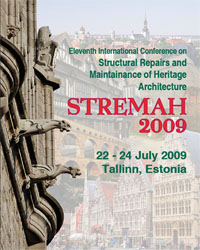
The 11th International Conference on Structural Repairs and Maintenance of Heritage Architecture was recently held in Tallinn. The conference series started in 1989 in Florence and since then they have been held in many locations all over the world including Seville (1991); Bath (1993); Crete (1995); San Sebastian (1997); Dresden (1999); Bologna (2001); Halkidiki (2003); Malta (2005); and Prague (2007).
STREMAH is now well established and recognised as the best meeting of its type attracting specialists from all over the world. Over the years the conference has continued to evolve and grow as the importance of the architectural heritage is becoming increasingly appreciated.
The series represents an important contribution to the state of the art in this field as each meeting gathers the most recent advances in research and up to date studies of heritage buildings to make them accessible to a wide circle of scholars and professionals.
Opening Address
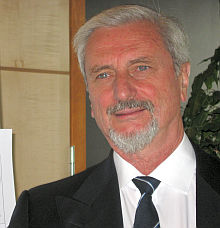 The meeting was opened by Professor Carlos A Brebbia as Chairman of the conference and Director of Wessex Institute of Technology (WIT). Professor Brebbia referred to the importance of the WIT conferences in bringing together different specialists in a friendly and productive environment. The meetings, Professor Brebbia said, are an important mechanism for inter and transdisciplinary communication. Many new developments originated at these conferences and gave rise to joint projects and publications including important books. WIT is interested in bringing forward new ideas and encouraging communication between physical sciences and humanities as well. This, Professor Brebbia said, is the only way to find solutions to the many challenges facing our society.
The meeting was opened by Professor Carlos A Brebbia as Chairman of the conference and Director of Wessex Institute of Technology (WIT). Professor Brebbia referred to the importance of the WIT conferences in bringing together different specialists in a friendly and productive environment. The meetings, Professor Brebbia said, are an important mechanism for inter and transdisciplinary communication. Many new developments originated at these conferences and gave rise to joint projects and publications including important books. WIT is interested in bringing forward new ideas and encouraging communication between physical sciences and humanities as well. This, Professor Brebbia said, is the only way to find solutions to the many challenges facing our society.Keynote Address by Professor Luigia Binda
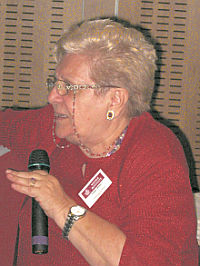 After welcoming the delegates, hoping that they will continue to collaborate with WIT, Professor Brebbia proceeded to introduce the keynote speaker, Professor Luigia Binda to whom the Conference Volume is dedicated. Professor Binda is an international authority on masonry research. Over the last 25 years, she has created a research group at the Department of Structural Engineering, Politecnico di Milano, working on Architectural Heritage.
After welcoming the delegates, hoping that they will continue to collaborate with WIT, Professor Brebbia proceeded to introduce the keynote speaker, Professor Luigia Binda to whom the Conference Volume is dedicated. Professor Binda is an international authority on masonry research. Over the last 25 years, she has created a research group at the Department of Structural Engineering, Politecnico di Milano, working on Architectural Heritage.
Her area of expertise in the field of preservation and structural restoration of historical buildings includes in-situ and laboratory experimental investigation for the evaluation of the mechanical and physical damage of masonry structures, limit analysis of masonry structures, effects of the chemical and physical alteration in the mechanical behaviour and the durability of masonry, long term behaviour of masonry under constant and cyclic loads and study of the seismic vulnerability of historic many buildings.
Her work is internationally renowned; she has participated in consulting work all over the world and organised post-graduate courses on the restoration of masonry structures.
Professor Binda contributed to the development of European standards and worked in close association with RILEM as well as other international institutions. Among her many awards and recognitions, she received in 2007 the Wessex Institute of Technology’s medal for outstanding scientific work during the STREMAH Conference held in Prague. WIT Press, the publishing arm of the Institute, launched Professor Binda’s very successful book “Learning from Failure” which presents the state of the art in heritage masonry research and applications.
Professor Brebbia then introduced the keynote address of Luigia Binda entitled “Difficulties in the design for conservation of archaeological remains: the G1 temple in My Son”, during which she described the work undertaken to conserve this important site which was built by the Cham people from the 5th to the 14th Century AD and partially destroyed by war, including the damage caused by shells during the Vietnam conflict. The idea was to produce guidelines for the conservation damage of these unique structures.
Keynote Addresses
Other important keynote addresses were:
- “Evolution of the lighthouses of Gdansk” by A Komorowski, Naval University of Gdynia, Poland
- “Modern solutions to historic problems: advanced materials and techniques in heritage applications” by P Lambert, Mott MacDonald, UK
- “Assessment of masonry strength in a heritage building” by M Holicky, Czech Technical University
- “An overview of masonry creep” by A Taliercio, Politecnico di Milano, Italy
- “Structural analysis of two metal de Dion roof trusses in Brussels model schools” by M de Bouw, Free University of Brussels, Belgium
- “Reactivation of headframes” by S Niederhagemann, Deutsches Bergbau Museum, Germany
- “Seismic vulnerability of historical adobe buildings in the coast of Peru” by C Cuadra, Akita Prefectural University, Japan
- “Earthquake behaviour of a reinforced concrete building constructed in 1933 before and after its state of repair” by G C Manos, Aristotle University of Thessaloniki
- “Estimation of the seismic resistance heritage buildings by dynamic testing of their structural parts” by I Iskhakov, Ariel University System of Samaria, Israel
- “The effect of earthquake characteristics on the collapse of historical masonry buildings: case study of the mosque of Takiyya al-Sulaymaniyya” by W Jager, Technical University of Dresden, Germany
Conference Topics
The substantial number of other presentations at the conference were classified under the following topics:
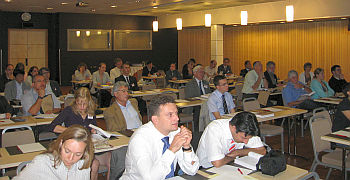 Heritage architecture and historical aspects
Heritage architecture and historical aspects- Structural issues
- Material characterisation
- Simulation and modelling
- Surveying and monitoring
- Assessment and retrofitting
- Seismic behaviour and vibrations
- Reuse of heritage buildings
- Heritage masonry buildings
Special Session on Modern Heritage
An important session was arranged on “Modern (19/20th Century) Heritage” consisting of the following papers:
- “Innovation in the current floor plan: zoning in blocks of flats for the middle class in the first half of the 20th century” by M Bostenaru Dan, ‘In Mincu’ University of Architecture and Urban Planning, Romania
- “The church of Saint Anthony of Padua in Zagreb: later additions to heritage” by N Jaksic, University of Zagreb, Croatia
- “Revitalisation strategies for modern glass facades of the 20th century” by U Pottgiesser, University of Applied Sciences, Germany
- “Environmental damage in XXth century architecture” by I Ozga, Institute of Atmospheric Sciences and Climate, CNR Bologna, Italy
- “The Peeters house in Deurne by Gaston Eysselinck: a Flemish ‘machine à habiter’” by A Verdonck, Free University of Brussels, Belgium
Social Functions
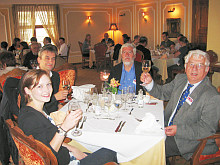 The conference offered ample opportunities for interaction amongst the delegates, not only through the formal sessions and discussions, but also at many social functions. The organisers arranged complimentary lunches to promote this interaction and the delegates were also offered the opportunity to attend the conference dinner.
The conference offered ample opportunities for interaction amongst the delegates, not only through the formal sessions and discussions, but also at many social functions. The organisers arranged complimentary lunches to promote this interaction and the delegates were also offered the opportunity to attend the conference dinner.
The conference dinner took place in a renowned restaurant in the main square of the old city of Tallinn. The room had a panoramic view of the famous Rathaus where the 2006 Prigogine Award Ceremony was held. The building where the restaurant is located is one of the oldest in the square and is well preserved, showing the interior of the house of an affluent citizen of Tallinn in the 17th Century. The excellent cuisine was complemented by good wines and local drinks. At the end of the evening a guitar and violin ensemble played a concert consisting of Estonian and regional music.
International Scientific Advisory Committee
The Scientific Advisory Committee met over dinner to discuss where to hold the 2011 Conference and how to improve its contents. The meeting owes its success to its continual evolvement since 1989. The composition of the ISAC was also discussed and new members nominated. They will add to the expertise of the Board and help to broaden the scope of the conference.Publication of Papers
 The proceedings of Structural Studies, Repairs and Maintenance of Heritage Architecture XI, 656pp (Print ISBN: 1-84564-196-2; Online ISBN: 1-84564-373-7; Print ISSN: 1746-4498) are available from WIT Press priced at £249/US$448/€324. Orders can be placed by telephone: +44 (0) 238 029 3223, fax: +44 (0) 238 029 2853, e-mail: This email address is being protected from spambots. You need JavaScript enabled to view it. or via the WIT Press web site at www.witpress.com
The proceedings of Structural Studies, Repairs and Maintenance of Heritage Architecture XI, 656pp (Print ISBN: 1-84564-196-2; Online ISBN: 1-84564-373-7; Print ISSN: 1746-4498) are available from WIT Press priced at £249/US$448/€324. Orders can be placed by telephone: +44 (0) 238 029 3223, fax: +44 (0) 238 029 2853, e-mail: This email address is being protected from spambots. You need JavaScript enabled to view it. or via the WIT Press web site at www.witpress.com
Papers from the conference will also be hosted online at the WIT eLibrary as Volume 109 of WIT Transactions on the Built Environment (Online ISSN: 1743-3509). For more details visit the WIT eLibrary at library.witpress.com


 Wessex Institute
Wessex Institute